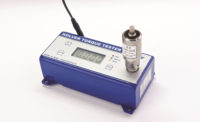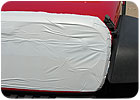
“Accidents are caused; they do not happen.” That was one my father’s favorite aphorisms when I was growing up. Hindsight being 20/20, perhaps I could have avoided breaking that pool cue or throwing a baseball through our kitchen window.
Be that is it may, accidents do happen, particularly in the hustle and bustle of a high-volume assembly plant. Seemingly minor accidents-such as a power tool slipping off a fastener and marring a Class A finished surface-can cost an assembler thousands of dollars annually. A scratch just 1 centimeter long costs, on average, $175 to repair.
Of course, that’s chump change if a scratched or dented assembly reaches the consumer. The cost of warranty claims, lost sales and consumer goodwill is incalculable.
Fortunately, there are ways to protect assemblies from accidental dings and scratches. A small investment in protective coverings can save assemblers thousands in repair bills.
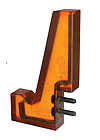
This urethane
pad was custom-made to hold a vehicle door as it’s transported down the
assembly line. Photo courtesy Exotic Automation & Supply
Protective Films
One way engineers can protect finished surfaces is by covering them with a thin plastic film.Protective films are typically made from low-density polyethylene, but they can also be made from polyvinyl chloride, polypropylene or polyethylene. The films protect against dirt and grease from hands and boots, scratches during handling, and impacts from small objects, such as stray fasteners.
The films are backed with a light, pressure-sensitive adhesive that has just enough tack to stick to the parts, but not so much that it leaves behind a residue or damages the surface upon removal. The adhesive is typically a low-tack water-based acrylic, but a variety of adhesive formulations is available, depending on the type and texture of the surface to be protected.
“We have films for LCD screens that provide just 1 ounce of tack,” explains Rick Pietrykowski, president of Surface Armor LLC, a supplier of protective films. “To put that in perspective, masking tape has 34 ounces of tack and duct tape has 65 ounces of tack.”
Protective films can be die-cut by the supplier, or they can be cut to shape on the shop floor. On the assembly line, films are usually applied manually, but some sheet metal suppliers can apply the film to steel or aluminum with a laminator as it’s being rolled.
In the automotive industry, protective films are applied to glass, seats, armrests, steering wheels, carpeting and painted surfaces, especially doors, fenders and bumpers. Aerospace manufacturers apply the films to carpets, windows, seats and canopies. Appliance assemblers use the films to protect buffed or brushed aluminum, stainless steel, painted metal, and glossy plastic housings. In the electronics industry, the films protect flat-panel displays, cell-phone lenses, touch screens, and metal and plastic frames and housings.
“Some computer parts are so highly polished, they show scratches like you wouldn’t believe,” says Pietrykowski.
Engineers are well-advised to test a variety of material and adhesive combinations before choosing a protective film for their application. The choice of film and adhesive depends on the base material, paint, surface texture, mold release agents, location, environmental factors, length of service, and costs.
Pietrykowski also stresses that protective films are intended for temporary use: Even low-tack pressure-sensitive adhesives can become more aggressive with age.
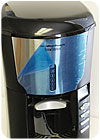
This protective film
is backed with a light, pressure-sensitive adhesive that has just enough tack
to stick to the parts, but not so much that it leaves behind a residue. Photo courtesy Surface Armor LLC
Reusable Plastic Shields
Protective films are typically applied after a product is fully assembled. However, more robust protection is often required on the assembly line, where fixtures, air hoses, nutrunners, sockets and even belt buckles represent hazards to carefully finished paint jobs. Reusable plastic shields provide that extra protection.A good example is the HardGuard line of shields from Apogee Designs Ltd. The shields consist of two layers. The impact-resistant outer layer is made from a proprietary blend of rigid high-density polyethylene and other resins. The material is hard enough to withstand a hit from a screwdriver dropped from a height of 32 inches without damage.
The soft inner layer is made from an energy-absorbing foam. The closed-cell foam doesn’t soak up fluids, and it has a high coefficient of friction, so it won’t slip off body pillars and other vertical surfaces.
Each shield is custom-made to fit a specific part, explains Nathan Baturka, HardGuard program manager. Apogee can produce a shield from a sample part or directly from CAD data. After the outer layer has been thermoformed and trimmed, the foam is cut to shape and bonded to the inside surface.
Manufacturers of cars, trucks, buses, motorcycles, military vehicles and even heavy equipment use plastic shields to protect fenders, fascias, doors, pillars, deck lids, steering wheels, instrument panels, radios and other finished or painted parts. The shields are less commonly used in the white-goods industry, where they are applied to refrigerator doors and other large, finished parts.
The shields stay in place by keying on particular part features, such as edges or gaps. If necessary, nonmarring suction cups can be added to keep the shield in place.
Shields can do more than just protect a part. Apogee has molded shields with features or pockets to hold tools, documents and transponders.
“We spend a lot of time with our customers to understand their process,” says Baturka. “Are people leaning over the vehicle? If so, what spots are they touching? Only then can we determine the best methods of protection.”
Shields aren’t only applied to parts and assemblies. They’re also applied to power tools, hose fittings and the tooling that holds and transports finished parts on the assembly line.
Exotic Automation & Supply has been making such products since 1963. The company’s portfolio of custom-made products includes carrier pads, finger bumper strips, wear pads, body rest pads, rollers, rail covers and bumper pads. The products are molded or machined from urethane, plastic or foam.
“We work with a wide range of materials that absorb energy and prevent scratches, dings and dents,” says Henry G. Testa, sales manager at Exotic Automation. “We work with our customers to identify where the damage is coming from, and then we come up with a tooling aid to eliminate the problem.”
Like shields applied directly to parts, pads for tooling are typically made for a specific product. “If the part stays the same, you can reuse them,” says Testa. “But usually, the part changes shape, so you need a new pad to nest it. Typically, our pads last the life of a program, or about five to seven years.”
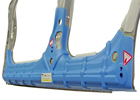
Nonmarring Sockets
Fastening tools don’t have to be dropped or dragged across a finished surface to cause damage. Just using the tool is enough to do harm. When the spinning socket rubs against the surface, it can leave behind a nasty circular scratch.Production Tool Co. has created a line of sockets that prevents this problem. The socket is covered with a free-spinning, nonmarring plastic sleeve that prevents metal-to-metal contact between the tool and the part. The plastic is soft enough to avoid scratching, but tough enough for constant use on an assembly line. The socket also contains a strong neodymium magnet that holds the fastener securely in place. This helps the assembler locate the hole and prevents the socket from slipping off the fastener during run-down. It also prevents dropped fasteners.
An additional benefit of the free-spinning sleeve is operator safety, says Ron Carpenter, president of Production Tool. The sleeve eliminates pinch points that can snag threads from work gloves.
“That tool could be spinning at over 1,000 rpm. If your glove gets caught, you could lose a finger,” says Carpenter, whose company also makes a line of nonmarring gap and flushness gauges.
In the automotive industry, the sockets are used to install fasteners on the “B column” for door locks and striker plates. They’re also used to install air bags, quarter panels, fenders, alloy wheels, wheel covers, seats, seat belts, shoulder belts, visors, and the bed to a pickup truck frame.

